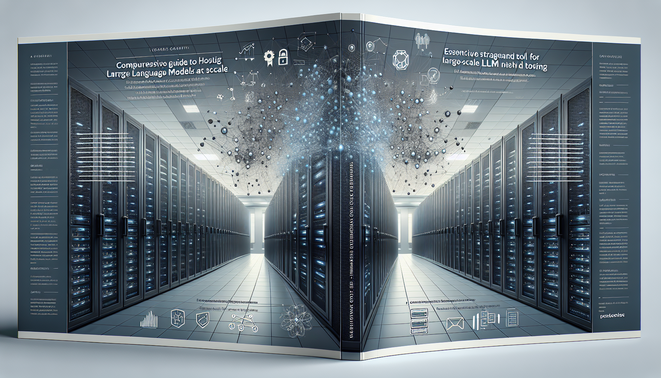Physical Address
304 North Cardinal St.
Dorchester Center, MA 02124
Physical Address
304 North Cardinal St.
Dorchester Center, MA 02124

Comprehensive Guide to Large-Scale LLM Hosting
Meta Summary: Discover essential strategies and tools for hosting Large Language Models (LLMs) at scale. This guide delves into architectural patterns, orchestration tools, and cost optimization to ensure efficient deployment and management of AI models.
Introduction to Large-Scale LLM Hosting
Large-scale LLM hosting is the process of deploying and managing extensive AI models designed to understand and generate human language. These robust models are vital for various applications, such as customer support and content generation, requiring a sturdy infrastructure for optimal performance.
Learning Objectives
Understand the fundamentals of large-scale LLM hosting.
Identify the requirements and challenges of deploying language models.
Hosting LLMs presents several challenges, including scalability, high availability, and cost management. These challenges arise from the need for significant computational resources, consistent uptime, and efficient data handling. Key components for setting up LLM hosting include:
Compute Resources: Powerful CPUs and GPUs to handle processing demands.
Storage Solutions: Efficient storage systems for managing large datasets and model checkpoints.
Networking Infrastructure: High-speed networks to facilitate data transfer and model updates.
Exercise: List the key components required for setting up an LLM hosting environment.
Architectural Patterns for LLM Deployment
Selecting the right architecture is crucial for efficiently deploying LLMs. Different architectural patterns have varying strengths and weaknesses, impacting performance and scalability.
Common Architectural Patterns
Monolithic Architecture: A single, unified codebase. While simple, it becomes unwieldy as the model grows.
Microservices Architecture: Breaks the application into smaller, independent services, facilitating scalability and maintainability.
Case Study: Microservices Architecture
An enterprise adopted a microservices architecture to deploy multiple LLMs. By compartmentalizing functionalities, they achieved better management and scalability. Key decisions included:
Implementing containerization for each service.
Using service discovery tools to manage inter-service communication.
Best Practice: Choose the right orchestration tools based on workload requirements to support your chosen architecture.
Orchestration Tools and Practices
Orchestration automates the management of computing systems, enabling seamless operations and scalability.
Popular Orchestration Tools
Kubernetes: Manages containerized applications, ensuring scalability and efficient resource use.
Docker Swarm: Simplifies container orchestration with straightforward setup and management.
Exercise: Set up a basic orchestration environment using Kubernetes for LLM deployment.
Pitfall: Neglecting to account for data ingress and egress costs when budgeting can lead to unexpected expenses.
Scaling Strategies for High Availability
High availability ensures that LLM systems remain operational and responsive under increased loads.
Strategies for Scaling
Horizontal Scaling: Adding more instances to distribute the load.
Vertical Scaling: Increasing the capacity of existing instances.
Best Practice: Regularly revisit and optimize infrastructure configurations to meet current load demands.
Pitfall: Overprovisioning resources without adjusting for actual usage patterns can waste resources and increase costs.
Monitoring and Maintenance of LLM Systems
Monitoring and maintenance are essential for sustaining LLM performance and preemptively addressing issues.
Monitoring Tools
Prometheus: An open-source monitoring framework for capturing metrics.
Grafana: Visualization software that integrates with Prometheus for real-time insights.
Maintenance Routines
Routine Updates: Regularly update software and models to incorporate improvements.
Performance Audits: Conduct audits to ensure systems operate efficiently.
Best Practice: Implement continuous monitoring and logging for proactive issue resolution.
Cost Management and Optimization in LLM Hosting
Efficient cost management is crucial for maintaining a sustainable LLM hosting environment.
Cost Management Techniques
Spot Instances: Utilize cost-effective cloud resources to reduce expenses.
Resource Right-Sizing: Adjust resource allocations based on actual usage patterns.
Exercise: Create a budget estimation for deploying an LLM in different cloud scenarios.
Pitfall: Failing to implement adequate security measures can lead to data breaches and associated costs.
Case Studies: Success Stories in LLM Deployments
Examining real-world examples provides valuable insights into effective LLM deployments.
Case Study: Startup Success
A tech startup utilized orchestration tools to scale their customer support chatbot, achieving a 30% increase in user satisfaction. Key implementations included:
Leveraging Kubernetes for automated scaling.
Employing continuous integration/continuous deployment (CI/CD) pipelines for seamless updates.
Visual Aid Suggestions
Diagram: A multi-tier architecture for LLM hosting with key components labeled and explained.
Screenshot: A dashboard from a monitoring tool showing LLM performance metrics.
Key Takeaways
Complexity of LLM Hosting: Managing LLMs at scale involves addressing challenges in architecture, orchestration, and cost management.
Architecture Matters: Choosing the right architectural pattern impacts scalability and maintenance.
Effective Orchestration: Tools like Kubernetes enhance scalability and operational efficiency.
Monitoring is Key: Continuous monitoring and proactive maintenance ensure high availability and performance.
Cost Optimization: Employing strategies like spot instances and resource right-sizing can significantly reduce costs.
Glossary
LLM: Large Language Model – a type of AI model designed to understand and generate human language.
Orchestration: The automated arrangement, coordination, and management of complex computing systems and services.
Scalability: The ability of a system to handle a growing amount of work by adding resources.
High Availability: A design approach that ensures a certain level of operational performance, typically uptime, for a longer than normal period.
Knowledge Check
What are the core components of an LLM hosting architecture?
A) Compute Resources
B) Storage Solutions
C) Networking Infrastructure
D) All of the above
Explain how orchestration tools improve the management of LLMs.
Further Reading
LLM Architecture Overview
Cloud Orchestration Tools
Scaling LLMs
This comprehensive guide provides foundational knowledge and practical insights needed to successfully host LLMs at scale. By understanding the nuances of architecture, orchestration, and cost management, organizations can harness the full potential of LLMs to drive business innovation and efficiency.